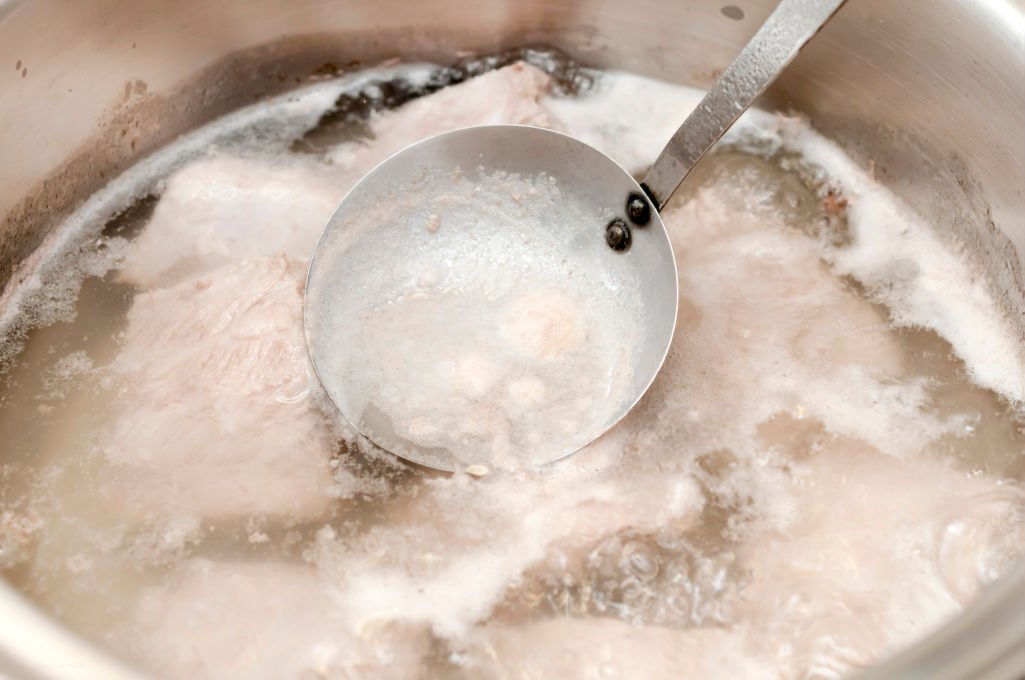Have you ever wondered why your favorite soups, sauces, and stews have that deep, satisfying taste? It all starts with a well-made stock. In this post, we’re going to talk about how making stock from scratch lays the groundwork for flavorful dishes. Whether you’re a home cook, a food enthusiast, or an amateur chef looking to boost your kitchen skills, this guide will walk you through every step. I’ll also share a bit of my own journey to show you how mastering this basic technique can truly change your cooking.
Introduction: The Heart of Flavor in Your Kitchen

Picture this: you’re simmering a pot of soup on a chilly evening, and the aroma fills your home with warmth. That incredible scent and flavor come from the stock that forms the base of your recipe. Stock is not just a liquid; it’s a concentrated blend of ingredients that brings depth and life to your dishes.
When I was in culinary school, stock making was a huge part of our daily routine. We made some form of stock every single day. It felt so routine that I didn’t fully appreciate its importance until I started experimenting with recipes where stock was the star—like ramen and pho. That’s when I realized that buying pre-made stock bases just wouldn’t cut it. Making stock from scratch opens up a world of rich, layered flavors that store-bought options simply can’t match.
In this blog post, we will cover:
- Why stock is the backbone of many dishes
- The basic components of a good stock
- Different types of stocks and their uses
- Techniques and tips for getting it right every time
- Common pitfalls and how to avoid them
- A personal look at my own stock-making journey
By the end, you’ll have a solid understanding of why stock is so important and how you can create it at home to elevate your cooking.
Why Stock Matters in Every Recipe
The Flavor Booster
Stock is much more than just water with a few extras. It acts as the flavor booster for your food. Think about it: when you use a homemade stock in a soup, sauce, or stew, your are layering your dish with tastes that come from hours of slow simmering. The flavors of bones, vegetables, and herbs slowly meld together to form what may call “liquid gold.”
Using a well-made stock gives you:
- Enhanced flavor: The long cooking time extracts every bit of goodness from your ingredients.
- Improved texture: The gelatin from the bones creates a pleasant mouthfeel.
- Balanced seasoning: Since your control when to add salt, you can tailor the taste perfectly for your dish.
The Secret to Depth and Complexity
A good stock brings a natural richness to your dishes. As it simmers, ingredients like meat, bones, and vegetables release amino acids such as glutamate. This creates the so-called “umami” effect—a savory taste that makes your food even more satisfying. This science behind the flavor helps explain why a dish tastes so much better when you use homemade stock instead of plain water.
The Building Blocks of a Great Stock

What You Need to Get Started
Making stock might seem like a long process, but once you understand the basic components, it becomes much simpler. Here are the key ingredients:
1. Bones and Meat
Bones are the main ingredient in meat-based stocks. They give the stock its body and provide gelatin, which is crucial for that silky texture. For example:
- Chicken bones are often used for a light, white stock.
- Beef or veal bones are great for richer, brown stocks.
- Fish bones make a delicate fish stock, but be careful not to use too many as they can overwhelm the flavor.
2. Vegetables and Aromatics
The magic of stock comes from aromatics like onions, carrots, celery, and garlic. These ingredients work together to create a balanced flavor. When combined in the right ratio, they provide a complex taste without overpowering the main ingredient.
3. Herbs and Spices
A small bundle of herbs—often called a bouquet garni—can add an extra layer of flavor. Common choices include thyme, bay leaves, and peppercorns. These herbs help accentuate the flavors extracted from the bones and vegetables.
4. Water
Water is the canvas on which all the flavors come together. Starting with cold water is key because it allows the gradual release of flavors and impurities, which you can then skim off for a clearer stock.
A Quick Comparison: Stock vs Broth
To clear up any confusion, here’s a table that shows the main differences between stock and broth:
| Feature | Stock | Broth |
|---|---|---|
| Main Ingredients | Bones (with some meat) | Meat (with or without bones) |
| Cooking Time | Longer (several hours) | Shorter (usually less than an hour) |
| Texture | Richer, more gelatinous | Lighter, more liquid |
| Usage | Foundation for sauces, soups, and gravies | Served as is or used in recipes |
| Flavor Profile | Deeper and more complex | Often milder |
This table should help your quickly see why making stock from scratch is so valuable in the kitchen.
Types of Stock and Their Uses
White Stock: The Light and Versatile Base
White stock is made with raw bones and ingredients that aren’t roasted before simmering. The process preserves the delicate flavors and results in a lighter, clearer stock. It’s the go-to choice for dishes like white sauces, blanquettes, and gentle poached recipes.
Brown Stock: The Rich and Robust Option
Brown stock is a bit more involved. The bones (and sometimes vegetables) are roasted first to develop a deep, caramelized flavor. This process, known as the Maillard reaction, gives the stock its characteristic color and robust taste. Brown stock is perfect for hearty sauces, gravies, and braised dishes.
Vegetable Stock: A Plant-Powered Alternative
Vegetable stock is ideal for vegetarian and lighter dishes. It relies on a mix of vegetables and herbs rather than bones to create flavor. This stock is lighter and works well in recipes where you don’t want meat flavors to interfere.
Fish Stock: The Delicate Choice
Fish stock, also known as fumet, uses the bones and trimming of lean, white fish. It’s very delicate and should be cooked for a shorter period to avoid a strong fishy taste. This type of stock is perfect for seafood soups and sauces.
Techniques and Tips for Perfect Stock
Start Cold and Simmer Slowly
One of the most common pieces of advice is to always start with cold water. When you add your bones, vegetables, and herbs to cold water and then heat it slowly, the flavors are drawn out more gently. This method also allows you to skim off impurities as they rise to the top, resulting in a clearer, better-tasting stock.
Don’t Let It Boil
It’s important to avoid boiling your stock. A rolling boil can break down the ingredients too quickly, leading to a cloudy liquid and off-flavors. Instead, let your stock simmer gently. This low, steady heat is what allows the flavors to develop gradually and beautifully.
Skip the Salt Early On
Hold off on adding salt during the stock-making process. Since the stock is often reduced later in recipes, adding salt too soon can lead to an overly salty final dish. You can always adjust the seasoning later when you’re closer to serving.
Regular Skimming

Keep an eye on your pot and skim off any foam or impurities that float to the top. This not only makes your stock look better but also improves its taste by removing any unwanted bits that can cause bitterness.
Timing Is Everything
Different types of stocks require different cooking times:
- White stock: Simmer for about 2 to 3 hours.
- Brown stock: Can take 4 to 6 hours for the best flavor extraction.
- Fish stock: Needs only about 20 to 30 minutes.
- Vegetable stock: Usually around 45 minutes to 1 hour is sufficient.
Using the right cooking time ensures that you get the maximum flavor without overcooking any of the ingredients.
Keep It Clear
A good trick to keep your stock clear is to chop your ingredients into even pieces. This increases the surface area, allowing more flavor to be released. Additionally, avoid stirring the stock too much once it starts to simmer. Let it work its magic.
Common Pitfalls and How to Fix Them
Even experienced cooks can run into issues when making stock. Here are some common mistakes and how you can avoid them:
Boiling Instead of Simmering
As mentioned, boiling can lead to a cloudy stock with off flavors. Stick to a gentle simmer to keep the flavors pure.
Adding Salt Too Early
Remember, the stock will often be reduced later, concentrating the salt. Hold off on salt until you’re using the stock in your recipe.
Overcrowding the Pot
If you add too many ingredients at once, the flavors may not meld together evenly. Give your ingredients enough room to move around in the water.
Not Skimming Off Impurities
If you don’t regularly remove the foam that forms on top, it can spoil the taste and clarity of your stock. Make it a habit of skimming off these bits as they appear.
Using the Wrong Bones
For a rich and flavorful stock, choose bones that have a good mix of meat and marrow. Bones from roasted chicken, beef, or veal work best. Avoid using bones that have too much excess fat, as this can make your stock greasy.
The Science Behind the Magic
Breaking Down the Flavor
During the slow cooking process, the ingredients in your stock undergo changes that unlock hidden flavors. Bones release collagen, which transforms into gelatin, giving the stock body and a silky texture. At the same time, the vegetables and aromatics contribute essential vitamins and minerals.
The process also breaks down proteins into amino acids like glutamate, which enhances the savory quality know as umami. This natural seasoning is what makes your dishes taste so satisfying even with minimal added salt.
pH and Its Role
The acidity or basicity (pH) of your stock can also affect flavor extraction. Some recipes call for a splash of acid, like a bit of lemon juice, to help draw out even more flavor from the ingredients. This is something you can experiment with to see how it changes the final taste of your dish.
Temperature and Time
Cooking your stock slowly over low heat is key. This careful process allows the flavors to develop gradually without the risk of boiling away important components. Patience is essential—good stock isn’t made in a rush.
Personal Reflections: My Stock-Making Journey
I want to take a moment to share a personal story with you. When I was in culinary school, stock making was one of those techniques that we practiced every day. It was a fundamental part of our training, something so routine that I initially thought it wasn’t a big deal. I used to buy stock bases from the grocery store because I believed it was good enough.
Everything changed when I began experimenting with recipes that put stock front and center—think homemade ramen and traditional pho. I realized that nothing compares to the rich, authentic flavor of a stock made from scratch. Each time I stirred a pot of slowly simmering stock, I remembered that even the simplest ingredients, when treated with care, can create something extraordinary.
That experience taught me that the foundation of flavor in any dish is built on the basics. Once you master stock making, you’ll see an immediate improvement in your cooking. Not only does your food taste better, but you also gain a deeper appreciation for the ingredients you use everyday.
Putting It All Together: A Step-by-Step Guide
Let’s bread down the stock-making process into a simple, step-by-step guide that you can follow in your own kitchen.
Step 1: Gather Your Ingredients
- Bones: Use chicken, beef, or fish bones depending on the type of stock you want.
- Vegetables: A basic mix of onions, carrots, celery, and garlic.
- Herbs: A bundle of thyme, bay leaves, and peppercorns.
- Water: Always start with cold water.
- Optional: A splash of acid like lemon juice for brightness (especially in vegetable or fish stocks).
Step 2: Prepare the Ingedients
- Roasting (for brown stock): Roast your bones in the oven until they are a deep golden color.
- Chopping: Cut your vegetables into even pieces. This helps release their flavors more efficiently.
Step 3: Combine and Heat
- Place your ingredients in a large stockpot.
- Cover them with cold water.
- Slowly bring the mixture to a gentle simmer.
- As the water heats, use a ladle to skim off any foam or impurities that rise to the surface.
Step 4: Simmer Gently
- White Stock: Let simmer for 2 to 3 hours.
- Brown Stock: Let simmer for 4 to 6 hours.
- Fish Stock: Only 20 to 30 minutes.
- Vegetable Stock: Around 45 minutes to 1 hour.
Be patient and resist the urge to let it boil. The gentle simmer is key to extracting all the good flavors.
Step 5: Strain and Store
- Once your stock has simmered to perfection, strain out the solids using a fine mesh strainer. Pro Tip: Ladle your stock from the pot to the strainer as much as you can before pouring the rest through the strainer. It allows small bits and piece to settle at the bottom of the stockpot resulting in a clearer stock.
- Allow the stock to cool, then store it in airtight containers. It can be refrigerated for up to a week or frozen for several months.
This straightforward process will help you create a stock that not only enhances your recipes but also makes your kitchen feel like a professional cooking space.
A Quick Recap in Table Form
To make things even easier, here’s a quick summary table outlining the key differences among the types of stock:
| Stock Type | Main Ingredients | Ideal Cooking Time | Best Uses |
|---|---|---|---|
| White Stock | Raw bones, vegetables | 2-3 hours | Soups, light sauces, poached dishes |
| Brown Stock | Roasted bones, vegetables | 4-6 hours | Gravies, braises, rich sauces |
| Fish Stock | Fish bones, lean fish | 20-30 minutes | Seafood soups, delicate sauces |
| Vegetable Stock | Vegetables, herbs | 45 minutes – 1 hour | Vegetarian dishes, light soups |
This table can serve as a handy reference when you’re deciding which type of stock to make based on the dish you have in mind.
Final Thoughts: Building Flavor, One Pot at a Time
Making stock from scratch might seep like a small step, but it’s one of the most powerful techniques you can add to your cooking repertoire. By preparing your own stock, you take control of the flavors in your dishes, ensuring that every bite is infused with depth and richness.
Not only does this process enhance the taste of your soups, sauces, and stews, but it also gives you a deeper connection to the food you prepare. The next time you step into your kitchen, remember that the secret to amazing flavor might just be simmering away on the stove.
I encourage you to experiment with different ingredients and techniques. Over time, you’ll develop your own methods and tweaks that work best for you. And who knows? You might even discover a new favorite recipe that starts with a humble pot of homemade stock.
Ready to Get Cooking?
Now that you know the basics and benefits of making your own stock, it’s time to put your knowledge into practice. I hope you feel inspired to take that first step toward creating your own foundation of flavor. Whether you’re cooking for your family, hosting a dinner party, or simply trying out a new recipe, a great stock will elevate every dish you make.
Remember, every great meal begins with a solid base. Start with a pot of simmering stock, and you’re already well on your way to creating something memorable.
If you found these tips helpful, please share your own stock-making experiences or any question you might have in the comments below. Your kitchen adventures could inspire someone else to explore this essential technique.
Happy cooking, and enjoy the journey of turning simple ingredients into delicious, soulful dishes!
Conclusion: Master Your Base, Master Your Cooking
In the end, making stock is all about mastering the basics. It’s a technique that allows you to build flavor from the ground up and make every dish you create taste more balanced and satisfying. Whether you’re new to cooking or have been at it for years, investing a little time in learning how to make stock can bring a big reward to your meals.
Take what you’ve learned here, experiment in your own kitchen, and don’t be afraid to adjust the process to suit your tastes. Every time you make a pot of stock, you’re not just preparing a recipe—you’re building a foundation that will support all your future cooking adventures.
So, roll up your sleeves, grab your favorite ingredients, and start simmering your way to culinary success. Your taste buds (and your family) will thank you.
Happy simmering, and here’s to many more delicious meals built on the simple, yet powerful, foundation of homemade stock!
Thank you for reading! I hope you enjoyed this deep dive into stock making and feel ready to create your own version of this culinary staple. If you have any thoughts, questions, or personal tips, please join the conversation in the comments below. Let’s learn and grow together in our kitchen adventures!